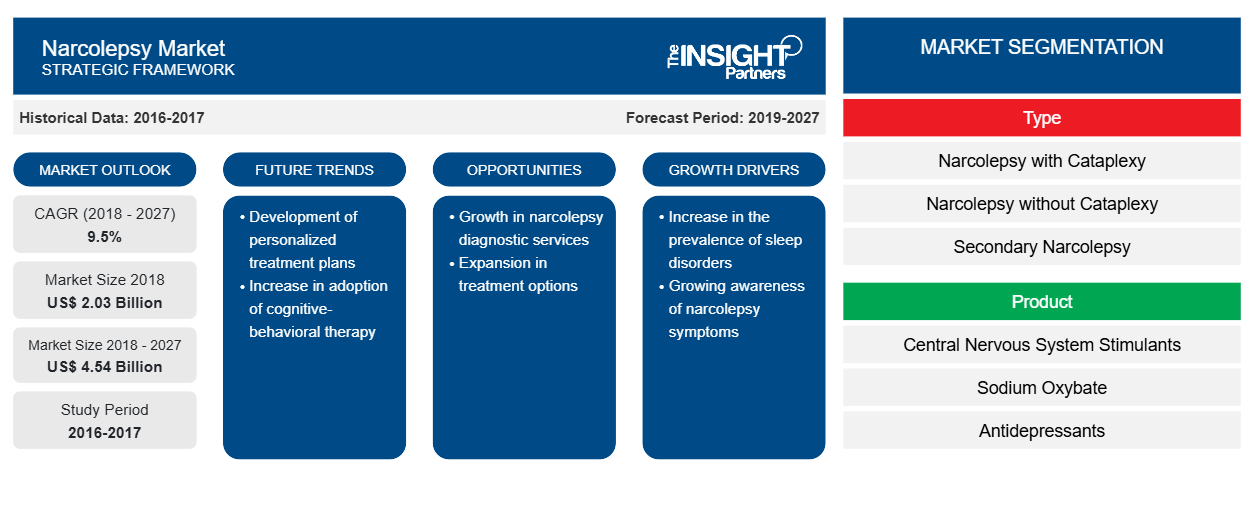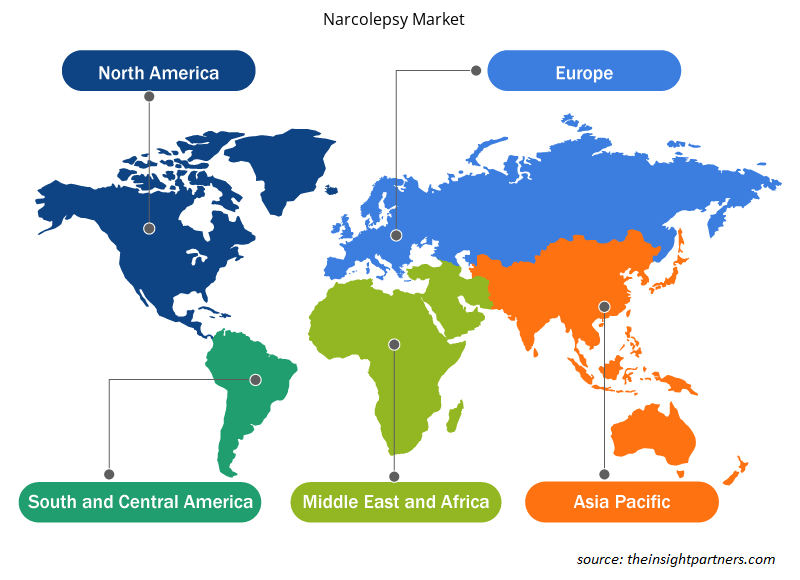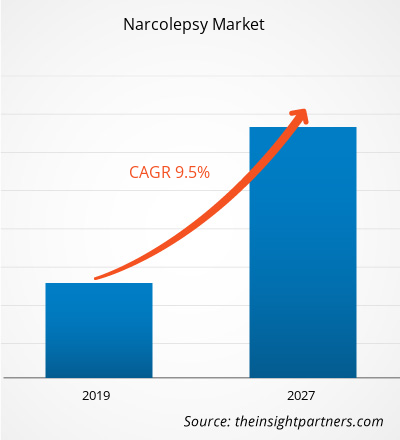The narcolepsy market size is estimated to reach US$ 4,537.9 million by 2027 from US$ 2,026.8 million in 2018; it is estimated to grow at a CAGR of 9.5% during 2019-2027.
Narcolepsy is a rare long-term brain disorder characterized by excessive sleepiness, sleep paralysis, hallucinations, and episodes of cataplexy among certain patients. Narcolepsy is known to occur equally among men and women, and the global incidence of narcolepsy is estimated to be roughly 1 in 2,000 people. People with narcolepsy feel very sleepy during the day and may involuntarily fall asleep during normal activities. Furthermore, narcolepsy is characterized by excessive drowsiness and sleep episodes. Narcolepsy makes it difficult for people to stay awake for lengthy periods of time and makes them sleepy for most of the day.
The narcolepsy market growth is attributed to the rising prevalence of sleep-related neurological disorders, emerging local pharmaceutical and biopharmaceutical companies, and increasing awareness regarding neurological disorders. However, side effects and risks associated with the narcolepsy medications and delayed diagnosis and misdiagnosis of the disease are likely to pose a negative impact on the narcolepsy market growth.
Customize This Report To Suit Your Requirement
You will get customization on any report - free of charge - including parts of this report, or country-level analysis, Excel Data pack, as well as avail great offers and discounts for start-ups & universities
Narcolepsy Market: Strategic Insights

- Get Top Key Market Trends of this report.This FREE sample will include data analysis, ranging from market trends to estimates and forecasts.
You will get customization on any report - free of charge - including parts of this report, or country-level analysis, Excel Data pack, as well as avail great offers and discounts for start-ups & universities
Narcolepsy Market: Strategic Insights

- Get Top Key Market Trends of this report.This FREE sample will include data analysis, ranging from market trends to estimates and forecasts.
Market Insights
Rising Prevalence of Sleep-Related Neurological Disorders Drives Narcolepsy Market
The range of sleep disorders that are treated by neurologists is wide and includes conditions such as insomnia, sleep apnea, restless legs syndrome, and narcolepsy. These disorders cause disruptions in the normal sleep–wake mechanisms causing endogenous abnormalities. Neurological sleep-related disorders are expected to increase in the coming years, as a large portion of the population will enter old age. According to the National Institute of Health (NIH), approximately 40 million Americans suffer from neurological diseases in the US and 20 million people experience occasional sleeping problems.
Over the last decades, much has been learned about the pathophysiology of narcolepsy. According to the National Center for Biotechnology Information, the prevalence of narcolepsy with cataplexy has been examined in many studies and falls between 25 and 50 per 100,000 people. Moreover, according to the Narcolepsy Network 2017, the condition affects 1 in every 2,000 people in the US, i.e., 200,000 Americans and approximately 3 million worldwide. Moreover, the American Sleep Apnea Association reports that sleep-related problems affect 50–70 million Americans of all ages and socioeconomic classes. However, important disparities in the prevalence and severity of certain sleep disorders have been identified in minorities and underserved populations. More than 50 million Americans already suffer from over 80 different sleep disorders and another 20–30 million suffer from intermittent sleep problems each year.
People with narcolepsy suffer from chronic daytime sleepiness and episodes in which they fall asleep unexpectedly during the day. These "sleep attacks" can occur at any time, during any activity. Sleep attacks are not limited to periods of dull or low engagement activities, but can happen during school or work hours, in the middle of a conversation, while eating, while exercising or playing sports, or even while driving. Thus, the surge in the prevalence of sleep-related neurological disorders is likely to propel the narcolepsy market’s trends forward during the forecast period.
Type-Based Insights
The global narcolepsy market, based on type, is segmented into narcolepsy with cataplexy, narcolepsy without cataplexy, and secondary narcolepsy. The narcolepsy with cataplexy segment held the largest share among the type subsegments in the narcolepsy market in 2018 and is also anticipated to witness a similar trend over the forecast period. Narcolepsy with cataplexy also referred to as Narcolepsy Type-1 is a rare neurological disorder that is diagnosed based on having low levels of a brain hormone (hypocretin) or reported events of cataplexy within an individual. Cataplexy refers to sudden and uncontrollable muscle weakness or paralysis that majorly occurs in a day and is often triggered by strong emotions, such as excitement or laughter. The person loses muscle tone and can have a slack jaw, broken speech, buckled knees, or total weakness in their face, arms, legs, and trunk, without much of a warning. The loss of muscle tone in cataplexy occurs because of the inability to regulate sleep and awake states. In about 10% of cases of narcolepsy, cataplexy is the first symptom to appear and can be misdiagnosed as a seizure disorder.
Product-Based Insights
The global narcolepsy market, based on product, is segmented into central nervous system (CNS) stimulants, sodium oxybate, and antidepressants. The sodium oxybate segment held the largest narcolepsy market share in 2018. Sodium oxybate is also known as gamma-hydroxybutyrate (GHB) is known to reduce daytime sleepiness and cataplexy by improving nighttime sleep in patients with narcolepsy. GHB is used to treat narcolepsy, a condition that causes severe daytime sleepiness. Sodium oxybate can decrease daytime sleepiness and also reduce the number of sudden short attacks of weak/paralyzed muscles (known as cataplexy) that can occur in patients with narcolepsy. This medication is highly effective for cataplexy. Sodium oxybate helps improve nighttime sleep, which is often poor in narcolepsy. In high doses, it may also help control daytime sleepiness. It must be taken in two doses, one at bedtime and one up to four hours later.
Distribution Channel-Based Insights
The global narcolepsy market, based on distribution channel, is divided into hospital pharmacies and retail pharmacies. The hospital pharmacies segment led the narcolepsy market in 2018. Hospital pharmacies refers to the medical pharmacies situated usually in the hospital premises. These pharmacies stock a large number of medications that majorly include specialized and investigational medications. Hospital pharmacies typically provide medications for hospitalized patients only and are not retail establishments. Hospital pharmacies may provide a huge quantity of medications per day allocated to the wards and intensive care units according to a patient's medication schedule. Larger hospitals may use automated transport systems to aid in the efficient distribution of medications.
Narcolepsy Market Regional Insights
The regional trends and factors influencing the Narcolepsy Market throughout the forecast period have been thoroughly explained by the analysts at Insight Partners. This section also discusses Narcolepsy Market segments and geography across North America, Europe, Asia Pacific, Middle East and Africa, and South and Central America.

- Get the Regional Specific Data for Narcolepsy Market
Narcolepsy Market Report Scope
| Report Attribute | Details |
|---|---|
| Market size in 2018 | US$ 2.03 Billion |
| Market Size by 2027 | US$ 4.54 Billion |
| Global CAGR (2018 - 2027) | 9.5% |
| Historical Data | 2016-2017 |
| Forecast period | 2019-2027 |
| Segments Covered |
By Type
|
| Regions and Countries Covered | North America
|
| Market leaders and key company profiles |
Narcolepsy Market Players Density: Understanding Its Impact on Business Dynamics
The Narcolepsy Market is growing rapidly, driven by increasing end-user demand due to factors such as evolving consumer preferences, technological advancements, and greater awareness of the product's benefits. As demand rises, businesses are expanding their offerings, innovating to meet consumer needs, and capitalizing on emerging trends, which further fuels market growth.
Market players density refers to the distribution of firms or companies operating within a particular market or industry. It indicates how many competitors (market players) are present in a given market space relative to its size or total market value.
Major Companies operating in the Narcolepsy Market are:
- Bioprojet
- Teva Pharmaceutical Industries Ltd.
- Jazz Pharmaceuticals, Inc.
- Graymark Healthcare, Inc.
- Arena Pharmaceuticals, Inc.
Disclaimer: The companies listed above are not ranked in any particular order.

- Get the Narcolepsy Market top key players overview
Product launches and approvals are commonly adopted strategies by companies to expand their global footprints and product portfolios. Moreover, the players focus on the partnership strategy to enlarge their clientele, which, in turn, permits them to maintain their brand name across the world. The market share is anticipated to flourish with the development of new innovative products by market players. Some of the market participants offering products are Teva Pharmaceutical Industries Ltd; Jazz Pharmaceuticals plc; Arena Pharmaceuticals, Inc; Graymark Healthcare, Inc; Novartis AG; Takeda Pharmaceutical Company Limited; Mylan N.V.; BIOPROJET; Shionogi & Co., Ltd; and Ligand Pharmaceuticals, Inc.
- Historical Analysis (2 Years), Base Year, Forecast (7 Years) with CAGR
- PEST and SWOT Analysis
- Market Size Value / Volume - Global, Regional, Country
- Industry and Competitive Landscape
- Excel Dataset
Testimonials
I wish to appreciate your support and the professionalism you displayed in the course of attending to my request for information regarding to infectious disease IVD market in Nigeria. I appreciate your patience, your guidance, and the fact that you were willing to offer a discount, which eventually made it possible for us to close a deal. I look forward to engaging The Insight Partners in the future, all thanks to the impression you have created in me as a result of this first encounter.
DR CHIJIOKE ONYIA, MANAGING DIRECTOR, PineCrest Healthcare Ltd.The Insight Partners delivered insightful, well-structured market research with strong domain expertise. Their team was professional and responsive throughout. The user-friendly website made accessing industry reports seamless. We highly recommend them for reliable, high-quality research services
Yukihiko Adachi CEO, Deep Blue, LLC.Reason to Buy
- Informed Decision-Making
- Understanding Market Dynamics
- Competitive Analysis
- Customer Insights
- Market Forecasts
- Risk Mitigation
- Strategic Planning
- Investment Justification
- Identifying Emerging Markets
- Enhancing Marketing Strategies
- Boosting Operational Efficiency
- Tracking Industry Innovations
- Aligning with Regulatory Trends
Yes! We provide a free sample of the report, which includes Report Scope (Table of Contents), report structure, and selected insights to help you assess the value of the full report. Please click on the "Download Sample" button or contact us to receive your copy.
Absolutely — analyst assistance is part of the package. You can connect with our analyst post-purchase to clarify report insights, methodology or discuss how the findings apply to your business needs.
Once your order is successfully placed, you will receive a confirmation email along with your invoice.
• For published reports: You’ll receive access to the report within 4–6 working hours via a secured email sent to your email.
• For upcoming reports: Your order will be recorded as a pre-booking. Our team will share the estimated release date and keep you informed of any updates. As soon as the report is published, it will be delivered to your registered email.
We offer customization options to align the report with your specific objectives. Whether you need deeper insights into a particular region, industry segment, competitor analysis, or data cut, our research team can tailor the report accordingly. Please share your requirements with us, and we’ll be happy to provide a customized proposal or scope.
The report is available in either PDF format or as an Excel dataset, depending on the license you choose.
The PDF version provides the full analysis and visuals in a ready-to-read format. The Excel dataset includes all underlying data tables for easy manipulation and further analysis.
Please review the license options at checkout or contact us to confirm which formats are included with your purchase.
Our payment process is fully secure and PCI-DSS compliant.
We use trusted and encrypted payment gateways to ensure that all transactions are protected with industry-standard SSL encryption. Your payment details are never stored on our servers and are handled securely by certified third-party processors.
You can make your purchase with confidence, knowing your personal and financial information is safe with us.
Yes, we do offer special pricing for bulk purchases.
If you're interested in purchasing multiple reports, we’re happy to provide a customized bundle offer or volume-based discount tailored to your needs. Please contact our sales team with the list of reports you’re considering, and we’ll share a personalized quote.
Yes, absolutely.
Our team is available to help you make an informed decision. Whether you have questions about the report’s scope, methodology, customization options, or which license suits you best, we’re here to assist. Please reach out to us at sales@theinsightpartners.com, and one of our representatives will get in touch promptly.
Yes, a billing invoice will be automatically generated and sent to your registered email upon successful completion of your purchase.
If you need the invoice in a specific format or require additional details (such as company name, GST, or VAT information), feel free to contact us, and we’ll be happy to assist.
Yes, certainly.
If you encounter any difficulties accessing or receiving your report, our support team is ready to assist you. Simply reach out to us via email or live chat with your order information, and we’ll ensure the issue is resolved quickly so you can access your report without interruption.















The List of Companies
- Bioprojet
- Teva Pharmaceutical Industries Ltd.
- Jazz Pharmaceuticals, Inc.
- Graymark Healthcare, Inc.
- Arena Pharmaceuticals, Inc.
- Shire (Acquired by Takeda)
- Ligand Pharmaceuticals, Inc.
- Novartis AG
- Mylan N.V.
- Shionogi Inc.






 Get Free Sample For
Get Free Sample For